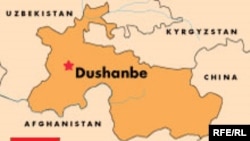Now, the Tajik government is similarly offering families in the central Khatlon region a chance to move west and cultivate unplowed land. It has pledged the equivalent of $500 to help each family find housing -- which is well over the country's average annual salary.
"Pursuant to the Tajik government order of January 31, 2006, on the resettlement of 1,000 families from various cities and districts in the Khatlon region to Tursunzadah, various ministries are working with local administrations to provide the necessary conditions," Sumagul Taghoeva, Tajikistan's first deputy minister of labor and social affairs, described the plan to RFE/RL's Tajik Service. "Each family gets 1,500 somoni, and this sum has been given to the first of the people who are moving."
New Neighborhood
Nearly 60 families began their moves to Tursunzadah this week. Officials are hoping to move about 1,000 families by the end of December.
It is unlikely that all of them are planning to work the land.
The city of Tursunzadah, near the Uzbek border, is one of Tajikistan's few industrial areas. The largest aluminum smelter in Central Asia is there, built under Soviet leadership in the 1970s. The Tursunzadah aluminum plant is one of Tajikistan's leading sources of export revenues.
During and after Tajikistan's civil war in the mid-1990s, criminal groups battled for control of the lucrative plant and violence in the city was common. Those groups were often ethnic Uzbeks, unsurprising since the Tursunzadah area is home to a mostly Uzbek population.
Ethnic Component?
Tajik political analyst Shokirjon Hakimov says he thinks this demographic imbalance is one of the reasons the Tajik government is eager to resettle ethnic Tajiks to the area.
"This is an artificial measure to transfer the traditions of people from one region to another [region] through resettlement," Hakimov says. "Of course, the goal is clear. In the Tursunzadah region, [the population is] mainly -- about 80 percent -- Uzbeks, and the region borders the Republic of Uzbekistan. So [authorities] want there to be more Tajiks in the Uzbek border region."
New neighbors might not ordinarily raise concerns in this country of around 7 million people. But the sudden influx of thousands of people will not go unnoticed in the Tursunzadah region, which is home to only around 70,000 residents.
It is unclear how well prepared local authorities are for any tensions that might accompany the newcomers from Khatlon. Official statements have ignored the ethnicity of either the settlers or the dominant population in Tursunzadah.
Hakimov suggests that the Tajik government might have been better served by resettling residents from the southwest of the country -- in the Hissar Valley close to the border with Uzbekistan -- where the population is mainly ethnic Tajik but people have much more experience with Uzbeks.
"It would have been better if they resettled people from the Hissar, Shari-Nau, and Karatagh [districts], because [those populations] know the traditions of this region better," Hakimov says. "That way, there would not be any problems because they would understand each other better."
Other Traditions
The move is far from the first time there have been resettlements in Tajikistan. Under the Soviet Union, inhabitants of the mountainous central and eastern parts of the country were forcibly moved to farming areas in the west and southwest, mainly to grow cotton. When civil war broke out following independence, many returned to their families' traditional homelands -- sometimes of their own desire and other times because they were forced out by more traditional residents.
The head of one of the families that is moving from Khatlon this week, Farhod Latipov, stresses that it was his own decision to move his wife and family the roughly 150 kilometers to find a new home.
"We are voluntarily moving," Latipov says. "The whole group [of families] is moving voluntarily. I myself am an engineer."
Tajikistan is not alone in Central Asia in pursuing policies that appear aimed at insulating border regions with representatives of the titular peoples. Turkmenistan has also forced out ethnic Uzbeks living near its border with Uzbekistan, as well as ethnic Kazakhs living along the Turkmen border with Kazakhstan.
Krushchev's "Virgin Lands" plan in the 1950s and 1960s called for cultivating previously fallow soil to increase grain production, mainly corn. That plan was widely regarded as a failure. But many farms started at the time are still producing. And the administrative center of those efforts -- then called Tselinograd -- is now Astana, the capital of Central Asia's economic leader, Kazakhstan.
(Normahmad Kholov of RFE/RL's Tajik Service contributed to this report.)
RFE/RL Central Asia Report

SUBSCRIBE For regular news and analysis on all five Central Asian countries by e-mail, subscribe to "RFE/RL Central Asia Report."













